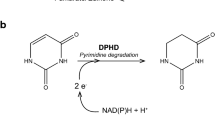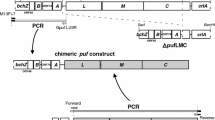Abstract
The cytochrome c gene (cycA) of the filamentous fungus Aspergillus nidulans has been isolated and sequenced. The gene is present in a single copy per haploid genome and encodes a polypeptide of 112 amino acid residues. The nucleotide sequence of the A. nidulans cycA gene shows 87% identity to the DNA sequence of the Neurospora crassa cytochrome c gene, and approximately 72% identity to the sequence of the Saccharomyces cerevisiae iso-1-cytochrome c gene (CYC1). The S. cerevisiae CYC1 gene was used as a heterologous probe to isolate the homologous gene in A. nidulans. The A. nidulans cytochrome c sequence contains two small introns. One of these is highly conserved in terms of position, but the other has not been reported in any of the cytochrome c genes so far sequenced. Expression of the cycA gene is not affected by glucose repression, but has been shown to be induced approximatly tenfold in the presence of oxygen and three- to fourfold under heatshock conditions.
Similar content being viewed by others
References
Ausubel FM, Brent R, Kingston RE, Moore DD, Seidman JG, Smith JA, Struhl K (1987) Current protocols in molecular biology. Greene Publishing Associates and Wiley Interscience
Barberis A, Superti-Furga G, Bussliner M (1987) Mutually exclusive interaction of the CAAT-binding factor and of a displacement protein with overlapping sequences of a histone gene promoter. Cell 50:347–359
Carter BLA, Bull AT (1971) The effect of oxygen tension in the medium on the morphology and growth kinetics of Aspergillus nidulans. J Gen Microbiol 65:265–273
Clark-Walker GD, Linnane AW (1967) The biogenesis of mitochondria in Saccharomyces cerevisiae. J Cell Biol 34:1–14
Courgeon AM, Rollet E, Becker J, Maisonhaute C, Best-Belpomme N (1988) Hydrogen peroxide (H2O2) induces actin and some heat shock proteins in Drosophila cells. Eur J Biochem 171:163–170
Dickerson RE, Tsunehiro T, Eisenberg D, Kallai OB, Samson L, Cooper A, Margoliash E (1971) Ferricytochrome c (1) General features of the horse and bonito proteins at 2.8Å resolution. J Biol Chem 246:1511–1535
Feinberg AP, Vogelstein B (1983) A technique for radio-labelling DNA restriction endonuclease fragments to high specificity. Anal Biochem 132:6–13
Fiechter A, Fuhrmann F, Käppeli O (1981) Regulation of glucose metabolism in growing yeast cells. Adv Microbiol Physiol 22:123–183
Forsburg SL, Guarente L (1988) Mutational analysis of upstream activation sequence 2 of the CYC1 gene of Saccharomyces cerevisiae: a HAP2-HAP3 responsive site. Mol Cell Biol 8:647–654
Guarente L, Mason T (1983) Heme regulates transcription of the CYC1 gene of Saccharomyces cerevisiae via an upstream activation site. Cell 32:1279–1286
Guarente L, Lalonde B, Gifford P, Alani E (1984) Distinctly regulated tandem upstream activation sites mediate catabolite repression of the CYC1 gene of Saccharomyces cerevisiae. Cell 36:503–511
Harmey MA, Neupert W (1985) Intracellular transport of mitochondrial membrane proteins. In: Martonosi A (ed) The enzymes of biological membranes, vol 4. Plenum, New York, pp 431–464
Kelly JM, Drysdale MR, Scaly-Lewis HM, Jones IG, Lockington RA (1990) Alcohol dehydrogenase in Aspergillus nidulans is anaerobically induced and posttranscriptionally regulated. Mol Gen Genet. 222:323–328
Kemmerer EC, Lei M, Wu R (1991) Structure and molecular evolutionary analysis of a plant cytochrome c gene: surprising implications for Arabidopsis thalania. J Mol Evolution 32: 227–237
Korb H, Neupert W (1978) Biogenesis of cytochrome c in Neurospora crassa: synthesis of apocytochrome c, transfer to mitochondria and conversion to holocytochrome c. Eur J Biochem 91:609–620
Laz TM, Pietras DF, Sherman F (1984) Differential regulation of the duplicated iso-cytochrome c gene in yeast. Proc Natl Acad Sci USA 81:4475–4479
Limbach KJ, Wu (1983) Isolation and characterisation of two alleles of the chicken cytochrome c gene. Nucleic Acids Res 11:8931–8949
Lindquist S, Craig EA (1988) The heat-shock proteins. Annu Rev Genet 22:631–677
Maniatis T, Fritsch EF, Sambrook J (1982) In: Molecular cloning, a laboratory manual. Cold Spring Harbor Laboratory Press, Cold Spring Harbor, New York
Margoliash E (1971) The molecular variations of cytochrome c as a function of the evolution of species. Harvey Lect 66:177–246
Margoliash E, Schejter A (1966) Cytochrome c. Adv Protein Chem 21:113–286
Mattoon J, Caravajal E, Guthrie D (1990) Effects of hap mutations on heme and cytochrome formation in yeast. Curr Genet 17:179–183
Messing J (1983) New M13 vectors for cloning. Methods Enzymol 101:20–78
Mount SM (1982) A catalogue of splice junction sequences. Nucleic Acids Res 10:459–472
Nye SH, Scarpulla RC (1990) Mitochondrial targeting of yeast apoiso-l-cytochrome c is mediated through functionally independent structural domains. Mol Cell Biol 10: 5763–5771
Pfeifer K, Prezant K, Guarente L (1987) Yeast HAP1 activator binds to two upstream activation sites of different sequences. Cell 49:19–27
Pillar TM, Bradshaw RE (1991) Heat shock and stationary phase induce transcription of the Saccharomyces cerevisiae iso-2-cytochrome c gene. Curr Genet 20:185–188
Pontecorvo G, Roper JA, Hemmons LM, MacDonald KD, Bufton AJW (1953) The genetics of Aspergillus nidulans. Adv Genet 5:141–239
Raeder U, Broda P (1985) Rapid preparation of DNA from filamentous fungi. Lett Appld Microbiol 1:17–20
Röhr M, Kubicek CP, Kominek J (1983) Citric acid. In: Rehm H-J, Reed G (eds) Biotechnology vol 3. Vert Chemie, Weinheim, pp 419–454
Sherman F, Stewart JW (1971) Genetics and biosynthesis of cytochrome c. Annu Rev Genet 5:257–296
Shih CN, Marth EH (1974) Aflatoxin formation, lipid synthesis, and glucose metabolism by Aspergillus parasiticus during incubation with and without agitation. Biochim Biophys Acta 338:286–296
Smith M, Leung DW, Gillam S, Astell CR (1979) Sequence of the gene for iso-l-cytochrome c in Saccharomyces cerevisiae. Cell 16:753–761
Southern EM (1975) Detection of specific sequences among DNA fragments separated by gel electrophoresis. J Mol Biol 98:503–517
Stuart RA, Neupert W, Tropschug M (1987) Deficiency in mRNA splicing in a cytochrome c mutant of Neurospora crassa: importance of carboxy terminus for import of apocytochrome c into mitochondria. EMBO J 6:2131–2137
Thomas PS (1980) Hybridisation of denatured RNA and small DNA fragments transferred to nitrocellulose. Proc Natl Acad Sci USA 77:5201–5205
Verdiére J, Creusot F, Guarente L, Slonimski PP (1986) The overproducing CYP1 and the underproducing hap1 mutations are alleles of the same gene which regulates in trans the expression of the structural genes encoding iso-cytochrome c. Curr Genet 10:339–342
Waldron C, Roberts CF (1973) Cytoplasmic inheritance of a coldsensitive mutant in Aspergillus nidulans. J Gen Microbiol 78:379–381
Zitomer RS, Montgomery DL, Nichols DL, Hall BD (1979) Transcriptional regulation of the yeast cytochrome c gene. Proc Natl Acad Sci USA 76:3627–3631
Zitomer RS, Sellers JW, McCartner DW, Hastings GA, Wick P, Lowry CV (1987) Elements involved in oxygen regulation of the Saccharomyces cerevisiae CYC7 gene. Mol Cell Biol 7:2212–2220
Author information
Authors and Affiliations
Additional information
Communicated by C. van den Hondel
Rights and permissions
About this article
Cite this article
Raitt, D.C., Bradshaw, R.E. & Pillar, T.M. Cloning and characterisation of the cytochrome c gene of Aspergillus nidulans . Molec. Gen. Genet. 242, 17–22 (1994). https://doi.org/10.1007/BF00277343
Received:
Accepted:
Issue Date:
DOI: https://doi.org/10.1007/BF00277343




